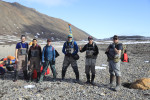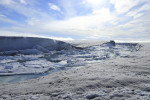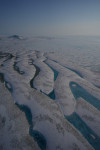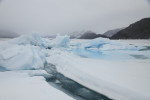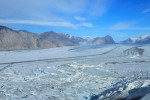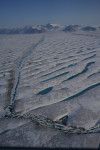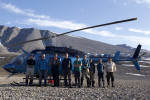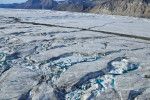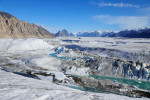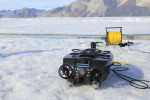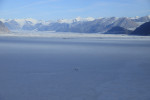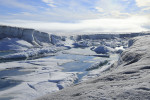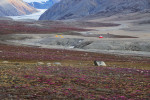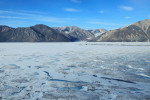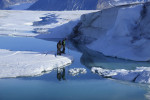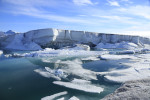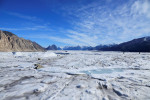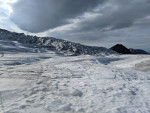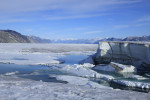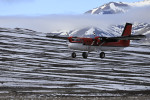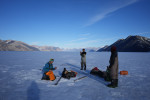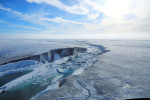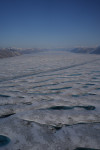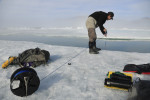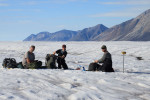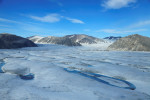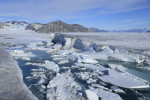Ellesmere Island – 2022
- Erik Wagenaar, Joseph Shoapik, Anna Crawford, Alex Forrest, Jérémie Bonneau and Dustin Patar get ready to hike to Milne Fiord to take measurements. Photo credit: Cameron Fitzpatrick
- The rift that formed in the Milne Ice Shelf following the 2020 calving event. Photo credit: Cameron Fitzpatrick
- The northern edge of the Milne Ice Shelf. Photo credit: Anna Crawford
- Thin ice in Milne Fiord gets pushed up in ridges as the glacier advances. Photo credit: Cameron Fitzpatrick
- The Milne Glacier thins out and starts to float here at the grounding line. Another glacier flows into the fjord down a steep slope on the right. Photo credit: Cameron Fitzpatrick
- The Milne Ice Shelf at the confluence of an old rift and the new one from 2020 (in the foreground) taken from a helicopter. Photo credit: Anna Crawford
- Our 2022 team (L-R): Jérémie Bonneau, René Gysler (pilot), Erik Wagenaar, Derek Mueller, Cameron Fitzpatrick, Alex Forrest, Joseph Shoapik, Anna Crawford and Dustin Patar Photo credit: Dustin Patar
- Floating ice breaks away from the Milne Glacier as it thins out and starts to float at the head of the fjord. Photo credit: Cameron Fitzpatrick
- An old rift that developed between the Milne Glacier and its floating ice tongue about 10 years ago. Photo credit: Cameron Fitzpatrick
- Our new underwater robot (‘Botley”) that is ready to explore otherwise inaccessible under ice environments in Milne Fiord. Photo credit: Cameron Fitzpatrick
- Looking up the Milne Fiord flying over the flat ice between the ice shelf (behind) and glacier (ahead). Alex Forrest and Anna Crawford are installing equipment to measure ocean properties over the next year. Photo credit: Cameron Fitzpatrick
- The rift that formed in the Milne Ice Shelf following the 2020 calving event. Photo credit: Cameron Fitzpatrick
- Our campsite and landing strip in Purple Valley. Photo credit: Cameron Fitzpatrick
- The thin and broken terminus of Milne Glacier’s floating ice tongue. Photo credit: Cameron Fitzpatrick
- Joseph Shoapik and Jérémie Bonneau profile through rifts in the ice shelf to measure the temperature and salinity of the water below. Photo credit: Cameron Fitzpatrick
- The rift that formed in the Milne Ice Shelf following the 2020 calving event. Photo credit: Cameron Fitzpatrick
- Joseph Shoapik and Anna Crawford measure the thickness of the Milne Glacier’s floating ice tongue using ice penetrating radar. Photo credit: Cameron Fitzpatrick
- Looking up at the ice falls near the terminus of the tributary glacier near the Milne Glacier grounding line. Photo credit: Cameron Fitzpatrick
- The Milne Ice Shelf at the confluence of an old rift (going off to the right) and the new one from 2020 (in the foreground). Photo credit: Cameron Fitzpatrick
- A Twin Otter approaches for a landing. Photo credit: Cameron Fitzpatrick
- Alex Forrest, Jérémie Bonneau and Joseph Shoapik prepare a mooring to measure temperature and salinity in Milne Fiord. Photo credit: Anna Crawford
- The rift that formed in the Milne Ice Shelf following the 2020 calving event from a helicopter taking off. Photo credit: Cameron Fitzpatrick
- Looking up the Milne Fiord over much of the current extent of the Mline Ice Shelf. Photo credit: Anna Crawford
- The rift that formed in the Milne Ice Shelf following the 2020 calving event. Photo credit: Cameron Fitzpatrick
- Derek Mueller, Anna Crawford and Erik Wagenaar take a break while a GPS measures the position of an ablation stake. Photo credit: Cameron Fitzpatrick
- The Milne Ice Shelf features elongated meltwater lakes that lie within undulations in the surface of the ice. Photo credit: Cameron Fitzpatrick
- ‘Mega’ Nunatak, rises above the Milne Glacier. The foreground is a tributary glacier that flows into Milne Fiord just below Milne Glacier’s grounding line. Photo credit: Cameron Fitzpatrick
- A view up the 2020 rift to the eastern side of the Milne Ice Shelf Photo credit: Cameron Fitzpatrick

